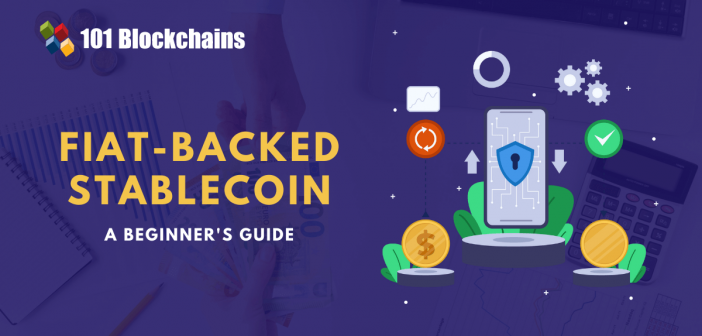Learn how blockchain truly works, master key definitions, and uncover what makes smart contracts so "smart." Dive into the fundamentals, gain valuable insights, and start your blockchain journey today!

- Cryptocurrency
James Howell
- on July 08, 2022
What is a Fiat-Backed Stablecoin?
One of the characteristic highlights of cryptocurrencies refers to price volatility. Many people interested in cryptocurrencies often turn away from the thought of unprecedented price fluctuations in the value of cryptocurrencies. In such cases, different stablecoin types have emerged as a solution to the issue of price volatility. Stablecoins have a unique feature in the fact that their value is pegged or associated with another stable asset such as precious metals or fiat currency.
The most common variant of stablecoins which has become a popular choice among crypto users, refers to fiat-backed stablecoins. The following discussion offers you an answer to ‘what is fiat-backed stablecoin’ along with an overview of its significance. In addition, you can also learn about some of the popular examples of fiat-backed stablecoins.
Want to learn the basic and advanced concepts of Stablecoin? Enroll Now in Stablecoin Fundamentals Masterclass Course!
Understanding Stablecoins
The first thing you need to learn before going through a fiat-backed stablecoin list is a clear understanding of stablecoins. Stablecoins are basically a specific class of cryptocurrencies designed specifically for introducing the price stability of fiat currencies while safeguarding the flexibility of digital assets. Stablecoins achieve price stability through association with a more stable asset such as fiat currencies like the US Dollar or precious metals such as gold.
The interesting highlight about stablecoins is that they have been tailored for maintaining price stability irrespective of the changes in the crypto market or the broader economy. The issuing organization would employ relevant mechanisms for stabilizing the price peg in event of unprecedented circumstances.
An overview of the notable stablecoin types can help you understand how stablecoins support price stability through different methods. As of now, you can discover around 200 stablecoins spread all over the world. Stablecoins safeguard crypto users from the unwarranted dangers of market volatility in cryptocurrencies. The most plausible use case of stablecoins refers to the ease of liquidating digital assets into stablecoins. Therefore, crypto users can keep their assets in the crypto ecosystem itself without converting them into fiat currency.
Types of Stablecoin
The next crucial aspect you need to learn to understand “what is a fiat-backed stablecoin” is an outline of the different types of stablecoin. Fiat-backed stablecoins are not the only stablecoins in the crypto market, although they are the most popular and commonly used stablecoins. You can also find crypto-pegged stablecoins and algorithm-backed stablecoins as the new alternatives to fiat-backed stablecoins.
-
Cryptocurrency-pegged Stablecoins
Crypto collateralization is also a proven method for maintaining the price peg for stablecoins. In this case, stablecoins are pegged against reserves of other cryptocurrencies, although with a significant twist. Cryptocurrencies are inherently more volatile in comparison to fiat currencies. Therefore, crypto-pegged stablecoins are generally over-collateralized for maintaining the price peg during periods of market volatility.
Want to become a Cryptocurrency expert? Enroll Now in Cryptocurrency Fundamentals Course
-
Algorithmic Stablecoins
Another new entry among the different types of stablecoin draws attention to algorithm-backed or algorithmic stablecoins. As evident from the name, algorithmic stablecoins use algorithms or smart contracts for managing the circulating supply of the stablecoin according to the market conditions. For example, the smart contract would reduce circulating supply when the stablecoin price drops. It would increase scarcity of the stablecoin and drive an increase in its value.
Wanto to learn about the types of stablecoins? Read here for What Are The Different Types Of Stablecoins now!
Definition of Fiat-backed Stablecoins
Stablecoins have been developed with the objective of facilitating broader adoption of cryptocurrencies. You can understand the importance of fiat backed stablecoin by identifying a clear definition of the same. The term “fiat-backed stablecoin” basically points to a stablecoin backed by a reserve of fiat currencies in regulated institutions like banks.
Fiat-backed stablecoins have an advantage over the other two stablecoin types in the fact that they are backed by actual fiat currencies. Crypto users can buy products and services online with fiat-pegged stablecoins, just like any other digital currency.
Another significant highlight of fiat-pegged stablecoins refers to the fact that their value is associated with the price of the underlying asset, i.e., fiat currency. Unlike the other two types of stablecoins, fiat-backed stablecoins don’t rely on the implications of supply and demand. As a result, fiat-pegged stablecoins are generally perceived as a more reliable form of cryptocurrency.
Using Fiat-backed Stablecoins
One of the significant highlights in a guide on ‘what is fiat-backed stablecoin’ refers to their usage. How can you get fiat-pegged stablecoins? Investors can exchange their fiat currency or cryptocurrency for purchasing fiat-backed stablecoins. You can sell the fiat-backed stablecoins by redeeming them for the corresponding amount of fiat currency. Crypto users can also sell their fiat-backed stablecoins for purchasing other cryptocurrencies.
Before you dive deeper into the importance of fiat backed stablecoin, you must note that fiat-pegged stablecoins don’t require mining processes. Fiat-backed stablecoins use centralized servers rather than blockchain technology and involve third parties in charge of the transactions.
Build your identity as a certified blockchain expert with 101 Blockchains’ Blockchain Certifications designed to provide enhanced career prospects.
How Can Stablecoins Serve You?
The purpose of stablecoins is also a critical element you need for understanding how fiat-backed stablecoins are relevant to the evolving crypto ecosystem. Stablecoins have been designed to offer a bridge between stable real-world assets and volatile digital assets. Apart from the inherent advantage of price stability, stablecoins serve many use cases. One of the prominent uses of stablecoins refers to liquidation of highly volatile crypto assets without leaving the crypto ecosystem.
Crypto users capitalize on the price stability element of stablecoins to reduce the transaction fees in purchasing or selling crypto assets. How? Many exchanges don’t impose transaction fees on crypto conversions to or from stablecoins. Rather than purchasing a specific cryptocurrency in fiat currency with transaction fees, you can use stablecoins. You can also cash out cryptocurrencies by converting them to stablecoins to ensure lower transaction fees. Therefore, stablecoins become popular during the time of market volatility.
Significance of Fiat-backed Stablecoins
The value benefits of stablecoin for crypto users serve a clear impression of how fiat-backed stablecoins can emerge as popular crypto assets. At the same time, you must be curious about the significance of fiat-backed stablecoins in the crypto landscape and the broader economy. Let us assume the best-case scenario for fiat-backed stablecoins to understand how they can shape the future of cryptocurrencies. The ideal fiat-backed stablecoins must prove successful in the three crucial areas of audits, regulations, and strength of reserves. Here is an overview of the essential pointers which validate the importance of fiat-pegged stablecoins.
-
Assurance of Regulations
The most noticeable highlight of a fiat-backed stablecoin is the need for regulation. Regulated stablecoins are obviously more trustworthy stablecoins, especially when they are pegged against fiat currency reserves. The fiat backed stablecoin example of Binance USD or BUSD shows how investors could capitalize on the safeguards of a regulatory body. On top of it, cooperation with regulatory authorities is an essential requirement for the future of stablecoins.
BUSD is under the regulatory ambit of the New York State Department of Financial Services. The issuer of BUSD, Paxos, and the stablecoin are under the regulation and supervision of NYFDS. As a result, BUSD is easily one of the first members among stablecoins with the support of regulatory compliance to safeguard user security. BUSD has also been green-listed on NYFDS, thereby offering pre-approval for trading and custody by virtual currency licensees of NYFDS.
-
Credibility with Audits
The example of BUSD in a fiat-backed stablecoin list also shows another aspect pertaining to their importance in the crypto ecosystem. Fiat-backed stablecoins could be as reliable as the reserves of fiat currencies backing them up. What if there is no cash reserve and stablecoin issuers claim otherwise?
Therefore, the ideal fiat-backed stablecoin must feature the facility for regular verification by trusted and neutral auditors. Regular audits can help stablecoin users know that they can access the reserves backing up their stablecoins. In most cases, stablecoin issuers release the audit reports on the underlying collateral on a monthly basis.
-
Strength of Reserves
The timely and credible audit of cash reserves underlying a fiat-backed stablecoin is obviously an important requirement for gaining the trust of users. On the other hand, the strength of the reserves of fiat currency backing up fiat-pegged stablecoins is an integral aspect of their functionality. What is a fiat-backed stablecoin without the fiat currency reserve to back it up? The fiat currency reserves are essential for maintaining the price peg, irrespective of market changes.
Therefore, an ideal fiat-backed stablecoin always comes with the backing of secure assets, which are less likely to experience any loss in value. Fiat-pegged stablecoins are the best option among stablecoin types as they offer price stability with reserves of steady currencies. The example of BUSD can showcase the importance of the strength of reserves for fiat-backed stablecoins.
BUSD maintains around 96% of reserves in cash and cash equivalents alongside the remaining 4% in US Treasury Bills. As a result, BUSD can have the best anchor with the USD peg, particularly when they are associated with US Treasury Bills, one of the most trusted securities. In addition, the issuer of BUSD, Paxos, offers a transparent process for minting and burning BUSD tokens. Regulations help the issuer impose remedial measures in response to illegal activity.
Want to understand what a stablecoin is and how it works quickly? Check the presentation Now on An Overview of Stablecoin
Advantages and Limitations of Fiat-backed Stablecoins
The understanding of fiat-pegged stablecoin basics and their importance bring you closer to the benefits and setbacks of fiat-backed stablecoins. Fiat-pegged stablecoins can ensure price stability and keep crypto users safe from market fluctuations. In addition, they allow users to stay within the crypto environment. Another significant advantage of fiat-backed stablecoins points to the ease of understanding the concept behind pegging against fiat currencies.
The importance of fiat backed stablecoin in the growth of crypto is clearly evident from their advantages. At the same time, you should also notice their limitations, such as the burden of regulations and intervention of centralized authorities. Fiat-backed stablecoin owners have to trust the custodian for safe storage of the cash reserves backing up the stablecoins. Regular audits can be quite resourced intensive for stablecoin networks, which might reflect in their collateralization. Above everything else, the centralization element in fiat-backed stablecoins deviates from the concept of decentralization in cryptocurrencies.
Examples of Fiat-backed Stablecoins
The discussion on fiat-pegged stablecoins is incomplete without a fiat backed stablecoin example and an understanding of how they are unique. Here are some of the most popular fiat-pegged stablecoins you can find right now.
-
Tether

Tether or USDT is one of the first stablecoins and is the most popular one. It has been pegged against the US Dollar, and the average trading volume of Tether amounts to almost $4 billion USD. As of now, it is one of the top cryptocurrencies in terms of daily trading volumes and market capitalization. However, Tether is a controversial entry in this fiat-backed stablecoin list considering the recent criticisms for the stablecoin. For example, Tether does not have adequate transparency pertaining to its methodology or official audits of its reserves.
-
Gemini Dollar

The Gemini Dollar or GUSD is another top example among fiat-backed stablecoins. The GUSD fiat-backed stablecoin has been created by the cryptocurrency platform Gemini and has the backing of the same. Gemini Trust Company is the issuer of the stablecoin and offers the advantage of regulation.
It has been subject to regulations under the New York State Department of Financial Services. You should notice the fiat backed stablecoin example of Gemini Dollar as an interesting improvement in over-centralization aspects in fiat-pegged stablecoins. Gemini Dollar is also available as an ERC-20 token which owners can redeem for the corresponding amount of USD through the Gemini exchange.
Get familiar with the terms related to cryptocurrency with Cryptocurrency Flashcards
Final Words
The detailed introduction to what is fiat-backed stablecoin and its importance showcase the massive scope for future of stablecoins. Designed as a tool against the price volatility in crypto markets, stablecoins can urge more users to adopt cryptocurrencies. As a trustworthy crypto asset, fiat-backed stablecoins offer the assurance of regulations and audits alongside powerful cash reserves.
The effectiveness of fiat-backed stablecoins is also evident in the opportunity to stay within the crypto landscape. However, it is also important to notice the critical limitations associated with fiat-backed stablecoins, such as centralization. On top of it, the impact of regulations could also create setbacks for adoption of stablecoins in certain use cases. Learn more about stablecoins and how they will shape the future of crypto-assets and the economy in general.
*Disclaimer: The article should not be taken as, and is not intended to provide any investment advice. Claims made in this article do not constitute investment advice and should not be taken as such. 101 Blockchains shall not be responsible for any loss sustained by any person who relies on this article. Do your own research!





